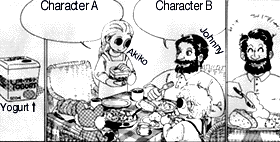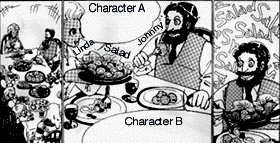|
|
EFL
Japan "a world of difference" |
|
|
|
||
|
|
EFL
Japan "a world of difference" |
|
|
|
||
| Next, let's take a look at the communication
function of offering/accepting, in the following two games (Games
4 and 5). Through a picture-word format it is easy to discern the components of a conversational context because settings, characters, social relationships, age, gender, dress, facial expressions, gestures, attitudes, and action are clear and synchronized, resulting in students becoming acutely aware of the importance of non-linguistic aspects of communication. Just for fun, compare this picture-word format with a words-only format to describe Game 4, and see how much longer it takes to communicate all the information. It is easy to see why the picture-word format is clearly a superior "tool" compared to a linear, words-only format or even a words-and-pictures format when our goal is to teach students how to use socially appropriate language. An experienced and qualified American teacher using a linear, words-only or words-and-pictures format might not be as effective as a native speaker who is inexperienced and untrained, but who is making use of a picture-word format. |
|
|
||
| Conversational Focus Akiko is asking Johnny if he'd like some yogurt ... アキコがジョニーにヨーグルトをすすめている。 |
Communication Function CharacterA / CharacterB Offering someone some food (ex. yogurt) /Accepting 食べ物(ヨーグルト)をすすめるには?/もらうには? |
Character A / Character B 1. Yogurt?/Sure! |
 |
||
|
|
||
| Conversational Focus Linda, the hostess, is asking Johnny if he'd like some salad ... リンダがジョニーにサラダをすすめている・・・ |
Communication Function CharacterA / CharacterB Offering someone some food (ex. salad) /Accepting 食べ物(サラダ)をすすめるには?/もらうには? |
Character A / Character B 1. (Would you) care for some salad? |
 |
||
|
|
|
||||
|
|
|
|
|
|
|
|
|
|
||||
|
|
|
|
|
|
|
|
|
|||||
|
|
|
|
|
|
|
|
|
|
||||
|
|
|
|
|
||